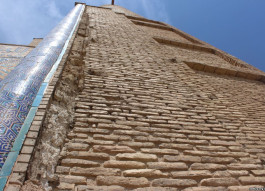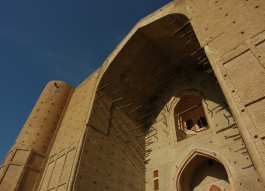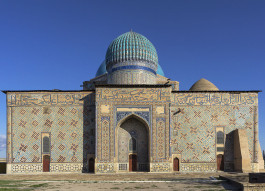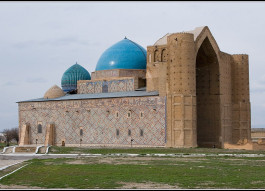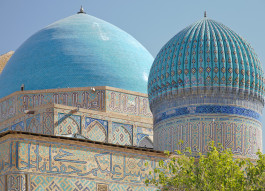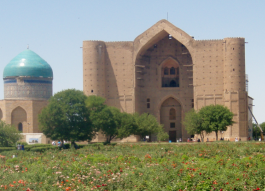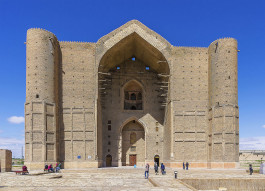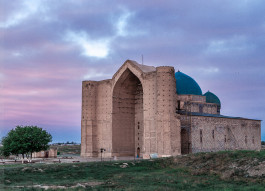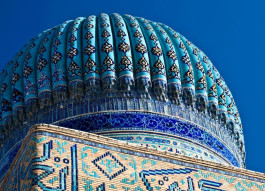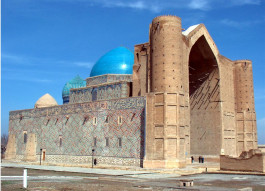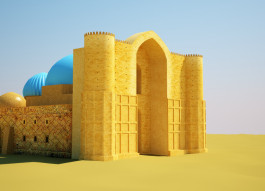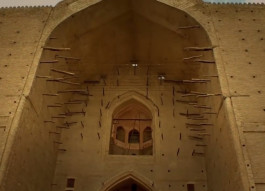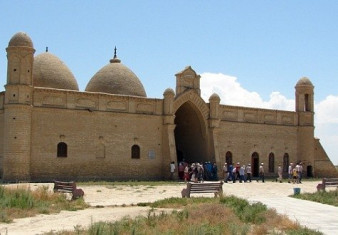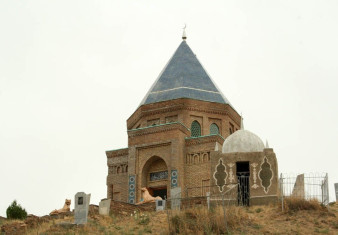 Holy places
Holy places
43.2957, 68.2846
Mausoleum of Khawaja Ahmed Yasawi is an unfinished mausoleum in the city of Turkestan, in southern Kazakhstan. The structure was commissioned in 1389 by Timur, who ruled the area as part of the expansive Timurid Empire, to replace a smaller 12th-century mausoleum of the famous Turkic poet and Sufi mystic, Khoja Ahmed Yasawi (1093–1166). However, construction was halted with the death of Timur in 1405.
Despite its incomplete state, the mausoleum has survived as one of the best-preserved of all Timurid constructions. Its creation marked the beginning of the Timurid architectural style. The experimental spatial arrangements, innovative architectural solutions for vault and dome constructions, and ornamentations using glazed tiles made the structure the prototype for this distinctive art, which spread across the empire and beyond.
The religious structure continues to draw pilgrims from across Central Asia and has come to epitomize the Kazakh national identity. It has been protected as a national monument, while UNESCO recognized it as the country's first site of patrimony, declaring it a World Heritage Site in 2003.
Location
The Mausoleum of Khawaja Ahmed Yasawi is situated in the north-eastern part of the modern-day town of Turkestan (formerly known as Hazrat-e Turkestan), an ancient center of caravan trade known earlier as Khazret and later as Yasi, in the southern part of Kazakhstan. The structure is within the vicinity of a historic citadel, which is now an archaeological site.
Remains of medieval structures such as other mausoleums, mosques and bath houses characterize the archaeological area. To the north of the Mausoleum of Khawaja Ahmed Yasawi, a reconstructed section of the citadel wall from the 1970s separates the historical area from the developments of the modern town.
History
Khoja Ahmed Yasawi corresponds to "master", also spelled as Khawajah Akhmet Yassawi, was the 12th-century head of a regional school of Sufism, a mystic movement in Islam which began in the 9th century. He was born in Ispidjab (modern Sayram) in 1093, and spent most of his life in Yasi, dying there in 1166.
He is widely revered in Central Asia and the Turkic-speaking world for popularizing Sufism, which sustained the diffusion of Islam in the area despite the contemporary onslaught of the Mongol invasion. The theological school he created turned Yasi into the most important medieval enlightening center of the area. He was also an outstanding poet, philosopher, and statesman. Yasawi was interred in a small mausoleum, which became a pilgrimage site for Muslims.
Arystan Bab Mausoleum is a mausoleum in Kazakhstan close to the village of Kogam and Otrartobe.
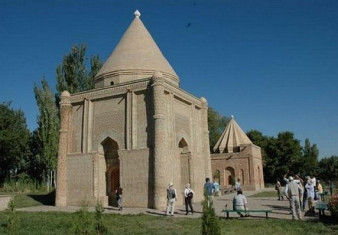
The Aisha-Bibi is in the west of Taraz, Kazakhstan on the Silk Road. It is locally famous as a monument to love and faithfulness.
Baydibek Karashauly (dates of birth and death are unknown) lived in the 11-12th centuries in the neighborhood of East Karatau, died in present Algabas district, near Aktas stud and buried on the river bank of Balabogen. The tomb established still in the ancient time with a dome remained.
Domalak Ana Mausoleum is a unique architectural monument of the South Kazakhstan.
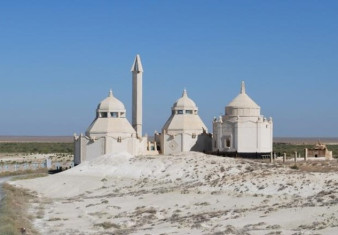
Beket-Ata Underground mosque is located in the Oglandy countryside, Mangystau region. This religious monument of architecture dates back to the XVIII century. Beket-Ata is considered as a holy place, in importance as a burial of Khozha Ahmed Yassaui. During two centuries, pilgrims come here for bowing the Holy Spirit.
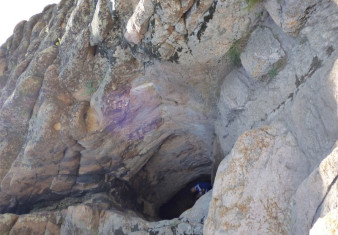
Everything that is known of this cave, is similar both on true and false at the same time. Local people say that there are three caves called Konyr-Auliye ("auliye" – sacred, the Saint) in Kazakhstan.














